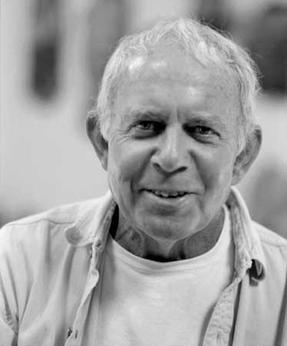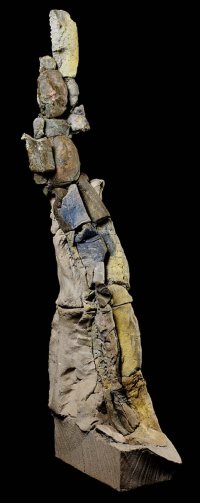Stephen De Staebler facts for kids
Quick facts for kids
Stephen De Staebler
|
|
|---|---|
 |
|
| Born | March 24, 1933 Webster Groves, Missouri, U.S.
|
| Died | May 13, 2011 (aged 78) Berkeley, California, U.S.
|
| Other names | Stephen de Staebler, Stephen Destaebler |
| Education | Black Mountain College, Brooklyn Museum Art School |
| Alma mater | Princeton University, University of California, Berkeley |
| Occupation | sculptor, ceramicist, educator |
| Employer | San Francisco State University, San Francisco Art Institute |
| Movement | California Clay Movement |
| Spouse(s) | Dona Merced Curley (m. 1958–1996; death) |
| Parents |
|
Stephen De Staebler (March 24, 1933 – May 13, 2011) was an American sculptor and teacher. He was best known for his amazing sculptures made from clay and bronze. His art often showed human figures that looked broken or incomplete. These sculptures explored ideas like how strong or fragile people can be. They also looked at how things grow and decay, and how we are connected to the earth. Stephen De Staebler was a very important artist in the California Clay Movement. He helped keep the tradition of making human figures in art alive after World War II.
Contents
Early Life and Art Beginnings
Stephen De Staebler was born in Webster Groves, Missouri, near St. Louis. He grew up in a town called Kirkwood. From a young age, his parents, Herbert and Juliette, encouraged his interest in art.
Many of Stephen's childhood summers were spent on his grandparents' large farm in Shoals, Indiana. He stayed in a simple cabin by the White River. This time in nature really shaped his artistic ideas. He once said he "fell in love with the river" and its carved bluffs. He felt that his artistic ideas were formed there as a child.
When Stephen was eight, his father took him to the St. Louis Art Museum. There, he saw a bronze copy of a famous Greek sculpture called Laocoön and His Sons. This artwork made a huge impression on him. After this, he started taking painting lessons. Later, he also took a private class to learn how to model with clay.
Stephen's Education
In 1950, Stephen De Staebler started studying at Princeton University. He learned about archaeology, art history, and religion. A former boxer named Joe Brown, who was known for his sports sculptures, was a mentor to Stephen. After his first year, Stephen went to a summer art program at Black Mountain College. There, he studied with the artist Ben Shahn.
In 1952, Stephen traveled to Europe. He visited many cities in Italy, Switzerland, France, and England. He saw famous artworks and buildings like Chartres Cathedral and sculptures such as the Belvedere Torso and Michelangelo's unfinished Captives. He also saw the Winged Victory of Samothrace in Paris and the Three Goddesses from the Parthenon in London. These experiences greatly influenced his art.
Two years later, Stephen graduated from Princeton with a degree in Religious Studies. His main project was about St. Francis of Assisi. After college, he joined the United States Army.
In 1957, he took ceramics classes at the Brooklyn Museum Art School. He studied with a teacher named Ka Kwong Hui. Soon after, Stephen moved to California with his first wife, Dona Merced Curley. He earned a master's degree in fine art from the University of California, Berkeley in 1961. At Berkeley, he studied with Peter Voulkos. Voulkos was a famous sculptor who helped make clay art seen as fine art, not just craft. Voulkos's ideas about clay's natural qualities really inspired Stephen.
Art Materials
Stephen De Staebler was known for using two main materials: clay and bronze.
Clay Sculptures
Stephen De Staebler's clay sculptures show off the natural qualities of clay. This was his main material when he started his career. He created raw, broken forms that looked like parts of the body or the landscape. Sometimes, they even looked like the landscape as a body. His art often explored the connection between earth and spirit, and how something can be both broken and whole, or fragile and strong.
He did not use traditional glazes on his clay. Instead, he mixed colored metal powders directly into the clay. After the clay was fired, it had soft, natural colors. These colors made the sculptures look even more like they came from the earth. A good example of his work is Seated Figure with Yellow Flame, which is at the Smithsonian American Art Museum.
Bronze Sculptures
In the late 1970s, Stephen started working with bronze. He turned to bronze after an injury made it hard for him to create large clay sculptures. Even though bronze is a very old art material, Stephen used it in his own unique way. He made his bronze sculptures look more open and free.
He explained that bronze allowed him to make figures stand on their own. This was harder to do with clay, which often needed a wide base. Bronze gave him the freedom to create sculptures that seemed to defy gravity. Their thin legs sometimes looked like they were about to fall. Stephen also started exploring wing-like shapes more in his bronze work. These wings had many meanings in myths, religion, and nature. Some of his famous winged figures include Winged Woman Walking and Winged Victory.
The Boneyard
Later in his career, Stephen De Staebler started using pieces of fired clay that he found in his "boneyard." This was a special area behind his studio where he had kept discarded clay bits for over 40 years. It was like an archaeological dig for him. He would put these recovered fragments together to create new forms. This process of using old pieces to make something new connected to his interest in life, death, and spiritual ideas. He said he would take "fragments that speak to one another" and combine them to make something bigger than the individual parts.
Stephen as a Teacher
After finishing his studies at Berkeley, Stephen De Staebler taught briefly at San Francisco State University. Then, from 1961 to 1967, he taught at the San Francisco Art Institute. In 1967, he returned to San Francisco State University and taught there until he retired in 1990. He worked with many other notable artists and teachers during this time.
In 1968, during protests against the Vietnam War, Stephen held some of his classes off campus. This was to keep his students safe from the police who were on campus.
Art Projects and Awards
Stephen De Staebler received many important requests to create art for public spaces. In 1963, he made Moab I for a bank in Salt Lake City, Utah. This sculpture is now at the Utah Museum of Fine Arts. In 1968, he created the altar, crucifix, and other pieces for the Holy Spirit Chapel at U.C. Berkeley.
Other places he created art for include:
- U.C. Berkeley Art Museum, 1970
- Bay Area Rapid Transit, Concord Station, 1972
- San Francisco Embarcadero Station, 1977
- Moscone Parking Garage in San Francisco, 1985–86
- Iowa State University, 1986
- Old St. Louis Post Office, Missouri, 1985–87
- New Harmony Inn and Convention Center, Indiana, 1986–98
- Embarcadero Center, San Francisco, 1990
- San Jose Convention Center, 1993
- Graduate Theological Union, U.C. Berkeley, 1993
- City Center Garage/Amphitheater, Oakland, 1993
- Chiron Corporation, Emeryville, 1998
Stephen De Staebler also received many awards for his work. These include two National Endowment for the Arts Fellowships (1979 and 1981) and a Guggenheim Foundation Fellowship (1983). He also won an award from the American Academy and Institute of Arts and Letters in 1989. In 1992, he won a special prize at an exhibition in Japan. In 1994, he was named an American Craft Council Fellow.
Later Life and Legacy
Stephen De Staebler passed away on May 13, 2011, in Berkeley, California. He was 78 years old.
2012 Art Show
After his death, a big art show of his work was held. From January to April 2012, the Fine Arts Museums of San Francisco showed his art at the M. H. de Young Memorial Museum. The show was called “Matter + Spirit: Stephen De Staebler.” A book with the same name was also published, featuring essays about his life and art.
Where to See His Art
Stephen De Staebler's sculptures are in many public art collections. You can find his work at places like the Berkeley Art Museum and Pacific Film Archive, the Crocker Art Museum in California, and the Fine Arts Museums of San Francisco. His art is also in the Los Angeles County Museum of Art, the Metropolitan Museum of Art in New York, and the Smithsonian American Art Museum in Washington D.C.
Images for kids
-
'Angel III', monotype on paper by Stephen De Staebler, 1995



